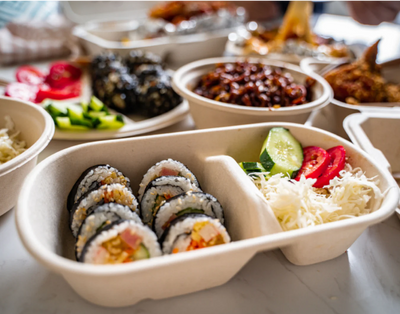When and where did all this begin, and what is plastic anyway? Let’s take a journey back into plastic history and look at how plastic has evolved and how it affects us now and in the future.
A Brief Biography Of Alexander Parkes
Alexander Parkes (1813-1890) was an English metallurgist and inventor. His greatest legacy was to create the first-ever man-made plastic: Parkesine. Being the son of a brass lock manufacturer, Parkes developed an interest and passion in the electroplating process as a teenager.Throughout his life, Parkes grew to be a successful scientist and inventor. He held at least 66 patents on various products and processes, especially focused on electroplating and plastic creation. Some of his inventions were found to be extremely valuable as they laid the groundwork for many modern scientific processes (these include: an improved method of electroplating fragile objects, the cold cure process for vulcanizing rubber, and an economical desilvering lead process.).

Parkesine: The First Man-Made Plastic And Its Features
Creating Parkesine - the first man-made plastic - took more than 10 years of Parkes’ life. In 1862, he publicly exhibited Parkesine for the first time at the London International Exhibition. Parkesine was made by dissolving nitrocellulose (a flammable nitric ester of cotton or wood cellulose) into solvents such as alcohol or wood naphtha and mixing it in plasticizers such as vegetable oil or camphor. He patented this in 1856 but took 6 years to complete his invention.Parkesine was technically an organic material with promising features. It was transparent, moldable when heated, and retained its shape when cooled. With the invention in hand, Parkes sought to make money. He began his business manufacturing and selling Parkesine. It was first produced to be used for small objects like jewelry, buttons, brush handles, and fountain pens. However, his business ultimately failed because his plastic was expensive to mass-produce, easily broken, and was flammable. Parkesine, though it is not used today, certainly molded our plastic history.

How Plastic Evolved In The Following Decades
A few years after Alexander Parkes’ invention, an American scientist, John Wesley Hyatt, created another type of plastic: Celluloid, derived from cellulose and alcoholized camphor. Celluloid was also moldable and durable in a variety of forms and shapes. Initially made as a substitute for ivory billiard balls, celluloid had its first real success as a flexible photographic film for movies in the 1900s. The plastic revolution began to warm up.In 1907, the first fully synthetic plastic, Bakelite, was invented by Leo Baekeland. This was a revolutionary breakthrough for the plastic industry. This new plastic contained no natural molecule and had completely advanced features with endless possibilities. This plastic was durable, moldable, heat-resistant, and easy to be taken into industrial mass production.
In the following years, more and more types of plastic were created to be increasingly multi-functional and less expensive. Some of the most popular to this day are Vinyl (1920s), Polyvinylidene Chloride (1933), Nylon (1939), and Thermoplastic Polyester (1970).
Mass Production Of Plastic Materials In The Modern Age
Alexander Parkes’ plastic company might have been unsuccessful, but his invention initiated a rise of a massive industry in modern society. According to a report by Ourworldindata, plastic production has increased 20 fold, reaching 8.3 billion metric tons of plastic in 2018. In the US alone, more than 500 billion plastic straws are used daily. Easily mass-produced, cheap, multifunctional, and durable, plastic production is common in every corner of the world.These days, plastic appears as chemical parts, food packaging, bottles and straws, stocking and electric equipment, and more. Most plastic is devoted to single-use products which is quickly disposed of but can take hundreds of years to begin decomposing. Most plastic that has ever been produced is still sticking around in landfills and oceans. In a recent discovery, scientists on Kurzgesagt found plastic waste in even the deepest part of the ocean.

Though plastic has become an incredibly versatile material in modern life, it cannot be denied that plastic has saturated the environment, our ecosystem, and is now finding its way into our bodies as well. Under UV rays, plastic breaks down into tiny invisible molecules, which infuses into the surrounding environment, creating soil and water pollution.
More alarmingly, these molecules can easily get consumed by marine animals like fish, crab, and shrimp and will later end up in our bodies. The fact that the amount of plastic waste in the environment will outweigh all fish by 2050 is raising serious concerns among everyone in addition to the experts.
What Can We Do To Stop This Plastic Crisis?.
Without a doubt, plastic is a harmful material to the environment and to human life. If we don’t quickly replace conventional plastic with eco-friendly alternatives, soon enough, we’ll be the ones to pay the price in the near future.Luckily enough, countries and companies have started to lead the way in a global “green movement”. Single-use plastic utensils are being restricted, banned, and replaced. Vanuatu and Seychelles were the first two countries to completely ban single-use plastic items. Other populated cities like Montreal, Taiwan, Malibu, and Seattle are also banning single-use plastic bags, straws, and other utensils in an effort to eliminate plastic from entering the ocean.
Worldwide companies and brands are taking steady movements to replace plastic straws with alternatives like paper straws or specially designed cups for drinking, such as Starbucks, Hyatt, American Airlines, Royal Caribbean, and more. Other enterprises are coming up with more eco-friendly, compostable, and affordable options such as grass straws, bamboo straws, and rice straws. These alternatives are promising to be the future of single-use straws since they are completely harmless to the environment and life.

If you want to join with us in protecting the environment and your life, as well as creating an eco-friendly lifestyle, then check out our 100% natural and biodegradable grass straws and rice straws here. If you have any questions, make sure to comment below! Remember that small actions can lead to big results!



